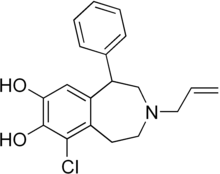SKF-82958
 | |
| IUPAC ime | |
|---|---|
3-alil-6-hloro-1-fenil-1,2,4,5-tetrahidro-3-benzazepin-7,8-diol | |
| Identifikatori | |
| CAS broj | 80751-65-1 |
| ATC kod | none |
| PubChem | CID 1225 |
| ChemSpider | 1188 |
| ChEMBL | CHEMBL317741 |
| Hemijski podaci | |
| Formula | C19H20ClNO2 |
| Molarna masa | 329,82 g/mol |
| |
SKF-82958 je sintetičko jedinjenje iz benzazepinske klase koje deluje kao pun agonist D1/D5 receptora.[1][2] SKF-82,958 i slični selektivni puni D1 agonisti kao što su SKF-81297 i 6-Br-APB proizvode karakteristične anorektičke efekte, hiperaktivnost i samoadministraciju kod životinja, sa sličnim mada ne identičnim profilom sa dopaminergičkim stimulansima poput amfetamina.[3][4][5][6][7][8][9][10][11]
Reference
[уреди | уреди извор]- ^ Pfeiffer, Francis R.; Wilson, James W.; Weinstock, Joseph; Kuo, George Y.; Chambers, Pamela A.; Holden, Kenneth G.; Hahn, Richard A.; Wardell, Joseph R., Jr.; Alfonso, J. Tobia; et al. (1982). „Dopaminergic activity of substituted 6-chloro-1-phenyl-2,3,4,5-tetrahydro-1H-3-benzazepines”. Journal of Medicinal Chemistry. 25 (4): 352—358. PMID 7069713. doi:10.1021/jm00346a005.
- ^ Wang JQ, McGinty JF (1997). „The full D1 dopamine receptor agonist SKF-82958 induces neuropeptide mRNA in the normosensitive striatum of rats: regulation of D1/D2 interactions by muscarinic receptors”. The Journal of Pharmacology and Experimental Therapeutics. 281 (2): 972—82. PMID 9152408.
- ^ Terry P, Katz JL (1992). „Differential antagonism of the effects of dopamine D1-receptor agonists on feeding behavior in the rat”. Psychopharmacology. 109 (4): 403—9. PMID 1365854. doi:10.1007/BF02247715.
- ^ Self DW, Stein L (1992). „The D1 agonists SKF 82958 and SKF 77434 are self-administered by rats”. Brain Research. 582 (2): 349—52. PMID 1356585. doi:10.1016/0006-8993(92)90155-3.
- ^ Rosenzweig-Lipson S, Hesterberg P, Bergman J (1994). „Observational studies of dopamine D1 and D2 agonists in squirrel monkeys”. Psychopharmacology. 116 (1): 9—18. PMID 7862937. doi:10.1007/BF02244865.
- ^ Kalivas PW, Duffy P (1995). „D1 receptors modulate glutamate transmission in the ventral tegmental area”. Journal of Neuroscience. 15 (7 Pt 2): 5379—88. PMID 7623160.
- ^ Weed MR, Woolverton WL (1995). „The reinforcing effects of dopamine D1 receptor agonists in rhesus monkeys”. The Journal of Pharmacology and Experimental Therapeutics. 275 (3): 1367—74. PMID 8531104.
- ^ Weed MR, Paul IA, Dwoskin LP, Moore SE, Woolverton WL (1997). „The relationship between reinforcing effects and in vitro effects of D1 agonists in monkeys”. The Journal of Pharmacology and Experimental Therapeutics. 283 (1): 29—38. PMID 9336305.
- ^ Abrahams BS, Rutherford JD, Mallet PE, Beninger RJ (1998). „Place conditioning with the dopamine D1-like receptor agonist SKF 82958 but not SKF 81297 or SKF 77434”. European Journal of Pharmacology. 343 (2-3): 111—8. PMID 9570457. doi:10.1016/S0014-2999(97)01531-8.
- ^ Tidey JW, Bergman J (1998). „Drug discrimination in methamphetamine-trained monkeys: agonist and antagonist effects of dopaminergic drugs”. The Journal of Pharmacology and Experimental Therapeutics. 285 (3): 1163—74. PMID 9618419.
- ^ Berridge KC, Aldridge JW (2000). „Super-stereotypy I: enhancement of a complex movement sequence by systemic dopamine D1 agonists”. Synapse. 37 (3): 194—204. PMID 10881041. doi:10.1002/1098-2396(20000901)37:3<194::AID-SYN3>3.0.CO;2-A.